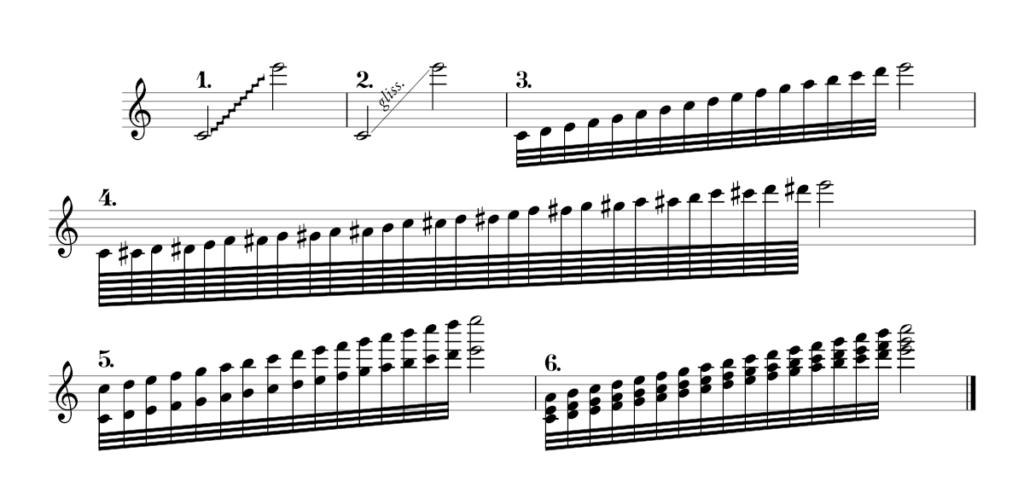Search Topic
The Art of the Glissando: A Comprehensive Guide for Musicians

Unlock the Expressive Power of the Glissando Technique
The glissando technique is a powerful musical tool that can elevate your performances and compositions to new heights. Mastering the art of the glissando unlocks a world of expressive possibilities, allowing you to seamlessly transition between notes and create mesmerizing, fluid soundscapes.
At its core, a glissando is a rapid, continuous slide between two notes, creating a smooth, uninterrupted melodic line. This technique is particularly effective in genres like classical, jazz, and contemporary music, where it can be used to convey emotion, build tension, or simply add a touch of elegance and sophistication to your musical creations.
Incorporating glissandos into your repertoire can be a game-changer, as it allows you to add depth, nuance, and a unique signature to your work. Whether you’re a seasoned musician or just starting your musical journey, understanding and incorporating the glissando technique can elevate your skills and captivate your audience.
Embrace the expressive power of the glissando, and unlock a new level of musical artistry that will leave a lasting impression on all who hear it.
The History and Evolution of the Glissando in Musical Compositions
The glissando is a captivating musical technique that has evolved and found its place across various genres throughout history. Originating from the Italian word “glissare” meaning “to glide,” the glissando technique involves smoothly sliding between two different notes, creating a distinct and mesmerizing effect.
In the realm of classical music, the glissando can be traced back to the Baroque era, where composers such as Bach and Handel incorporated it to add dramatic flair and emotional depth to their compositions. As musical styles progressed, the glissando continued to captivate audiences, becoming a staple in the works of Romantic-era composers like Liszt and Chopin.
But the glissando’s influence extends far beyond the classical realm. In the world of jazz, the technique has been embraced by virtuosic instrumentalists, from the soulful saxophone glissandos of John Coltrane to the dazzling piano runs of Art Tatum. Similarly, in the realm of rock music, the glissando has been utilized by legendary guitarists like Jimi Hendrix and Eddie Van Halen to add a touch of virtuosity and flair to their performances.
Undoubtedly, the glissando has proven to be a versatile and enduring musical device, transcending genre boundaries and captivating audiences across the centuries. As we delve deeper into the history and evolution of this mesmerizing technique, we can’t help but appreciate the profound impact it has had on the rich tapestry of musical expression.
Mastering the Glissando: Essential Techniques and Tips for Instrumentalists
The glissando is a captivating musical effect that can elevate your performances and leave your audience spellbound. As an instrumentalist, mastering the glissando is an essential skill that can add depth, emotion, and virtuosity to your playing. Whether you’re a pianist, guitarist, violinist, trumpeter, or trombonist, understanding the proper techniques and incorporating strategic practice is key to unleashing the full potential of this expressive technique.
On the piano, a glissando is achieved by sliding your fingers rapidly across the keys, creating a smooth, cascading effect. Guitarists can produce a glissando by sliding their fretting hand up or down the neck, while violinists can create a glissando by swiftly moving their fingers up or down the strings. Brass instrumentalists, such as trumpeters and trombonists, can execute a glissando by adjusting their embouchure and air support to seamlessly transition between notes.
Consistent, focused practice is the foundation for developing a masterful glissando. Incorporate glissando exercises into your daily routine, gradually increasing the speed and fluidity of your movements. Experiment with different fingerings and hand positions to find what works best for your instrument and playing style. With dedication and patience, you’ll soon be able to effortlessly incorporate captivating glissandos into your musical repertoire.
The Emotional Impact of the Glissando: Leveraging it for Expressive Musical Performances
When it comes to eliciting powerful emotions in music, the glissando is a technique that deserves serious attention. This smooth, sliding transition between notes has an uncanny ability to tug at the heartstrings and transport listeners to new realms of feeling. By understanding the emotional potential of the glissando, musicians can wield this tool to craft performances that are nothing short of spellbinding.
At its core, the glissando evokes a sense of fluidity and continuity that can be incredibly impactful. The seamless slide between pitches creates a sense of longing, anticipation, or even melancholy that resonates on a primal level. In the hands of a skilled performer, the glissando becomes a means of directly communicating emotion, bypassing the rational mind and speaking directly to the listener’s soul.
Whether incorporated into improvised passages or thoughtfully placed within a composed work, the glissando is a versatile technique that can elevate the expressive power of any musical performance. From the soulful wail of a blues guitar to the soaring melodies of a classical concerto, the judicious use of the glissando can imbue a piece with unparalleled emotional resonance.
Aspiring musicians would do well to explore the nuances of the glissando and how it can be leveraged to create truly captivating musical experiences. By mastering this emotive device, performers can unlock new realms of expression and forge a deeper connection with their audience – one note at a time.
Incorporating the Glissando into Your Musical Repertoire: Creative Approaches and Inspirations
The glissando is a powerful musical technique that can infuse your compositions with a captivating, emotive quality. Far from being a mere ornamental flourish, the strategic incorporation of glissandos can elevate your music to new heights, evoking a range of moods and textures.
Whether you’re a songwriter, arranger, or music producer, mastering the art of the glissando can open up a world of creative possibilities. From lush, sweeping string arrangements to the soulful bends of a blues guitar, this technique can lend an organic, almost human-like expressiveness to your musical creations.
Experiment with deploying glissandos in different contexts and genres – you may be surprised by the transformative effect they can have. Try weaving them into the melodic lines of your songs, or using them to create striking transitions between sections. In electronic music production, glissandos can inject a sense of movement and fluidity, blurring the boundaries between individual sounds.
The key is to approach the glissando with intention, using it to serve the larger emotional and artistic vision of your music. With practice and an open, creative mindset, you’ll unlock a powerful new dimension to your compositional toolkit.
Conclusion: Embrace the Glissando and Elevate Your Musical Artistry
In conclusion, mastering the glissando technique can truly elevate your musical artistry and add a new dimension to your performances. By incorporating this expressive and versatile technique into your repertoire, you can captivate your audience and bring your music to life in a whole new way. To delve deeper into the art of the glissando, be sure to check out our comprehensive guide on Plugintutor’s blog, where you can unlock even more tips and tricks to enhance your musical journey.








